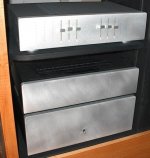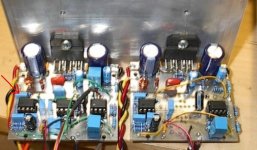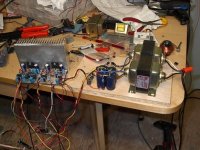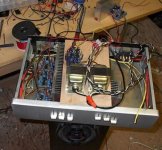I have just received my order from Digikey (placed it at 10pm last night!). FAST service.
I've been busy with the speakers for these amps here:
http://www.diyaudio.com/forums/showthread.php?s=&threadid=106736
But I've reached the final finishing stages on those so time to concentrate on the amps again.
I ordered all of the necessary parts to complete the six active amps plus a few odds and ends for other things, such as the soft start for the power supply.
Here's a less than perfect picture of the three units together. On the bottom: the power supply, the middle: he subwoofer amp and on top: the empty multichannel active amp.
I've been busy with the speakers for these amps here:
http://www.diyaudio.com/forums/showthread.php?s=&threadid=106736
But I've reached the final finishing stages on those so time to concentrate on the amps again.
I ordered all of the necessary parts to complete the six active amps plus a few odds and ends for other things, such as the soft start for the power supply.
Here's a less than perfect picture of the three units together. On the bottom: the power supply, the middle: he subwoofer amp and on top: the empty multichannel active amp.
Attachments
Worked yesterday on a new lowpass board (the one built earlier is too jumbled up with used components and changes). Everything went smoothly, got all the components in the right place, op-amps in the sockets the correct direction. Hooked it up to my temporary (becoming permanent) sower supply. 15v +/- cut down from the 35V with resistors and zeners.
With power on, there's a crackling, popping sound - like static on an old AM radio. I jiggle a few wires - no difference.
This sound continues and stops and starts again, completely random. I turn on the CD player to see if it's working at all and I get sound, but the noise continues. I try a bunch of different things with no result. I think maybe the 15V supply is no good, use a different one, no improvement. I gave up.
An hour later I go back. Turn it on, crackles are there and then stop. Dead silence. I touch the signal side of the input - it hums. Turn on the music - it plays clean.
I leave it going while I start to put together a midpass board. The static doesn't return.
Today, I try it again and the static is back, but doesn't last long. I'd really like to know what the problem is.
I've tried almost everything. There is no sign of oscillation, DC offset at maximum output (pot all the way up) is 20mV. Put extra bypass caps, changed op-amps, etc.
Any ideas?
I would write it off, but the midand board is doing the same thing.
With power on, there's a crackling, popping sound - like static on an old AM radio. I jiggle a few wires - no difference.
This sound continues and stops and starts again, completely random. I turn on the CD player to see if it's working at all and I get sound, but the noise continues. I try a bunch of different things with no result. I think maybe the 15V supply is no good, use a different one, no improvement. I gave up.
An hour later I go back. Turn it on, crackles are there and then stop. Dead silence. I touch the signal side of the input - it hums. Turn on the music - it plays clean.
I leave it going while I start to put together a midpass board. The static doesn't return.
Today, I try it again and the static is back, but doesn't last long. I'd really like to know what the problem is.
I've tried almost everything. There is no sign of oscillation, DC offset at maximum output (pot all the way up) is 20mV. Put extra bypass caps, changed op-amps, etc.
Any ideas?
I would write it off, but the midand board is doing the same thing.
After my last post, I went back for another try. I re-check everything and re-heat each joint with my iron. I must have performed some magic because there's no static now.
Leave the lowpass connected and connect the midpass. Power on, bass but no midrange. Turn the pot all the way up - I can just hear it. Poke and prod and the crackling starts. There's one 3.3nF cap that seems to be the problem. I re-solder it and presto! I have midrange. I leave both running for 30 minutes or so with music. No static, no problems.
Hopefully tomorrow when I try them they will still be "fixed".
I'll begin a highpass now, maybe with more luck (more careful soldering).
In the picture the red arrow at the left points to the offending cap on the midband board.
Leave the lowpass connected and connect the midpass. Power on, bass but no midrange. Turn the pot all the way up - I can just hear it. Poke and prod and the crackling starts. There's one 3.3nF cap that seems to be the problem. I re-solder it and presto! I have midrange. I leave both running for 30 minutes or so with music. No static, no problems.
Hopefully tomorrow when I try them they will still be "fixed".
I'll begin a highpass now, maybe with more luck (more careful soldering).
In the picture the red arrow at the left points to the offending cap on the midband board.
Attachments
Well, the lowpass stayed "fixed" but the midpass board started crackling this morning. I turned the power on and they were quiet for about 10 minutes, then the static started in the midpass. I poked and jiggled the components around with no result.
I then had the idea that heat has something to do with it, since the static doesn't happen after they are warm. I used my heat gun to heat up the midpass board and the static stopped.
This is driving me crazy.
I then had the idea that heat has something to do with it, since the static doesn't happen after they are warm. I used my heat gun to heat up the midpass board and the static stopped.
This is driving me crazy.
This crackling, static problem seems to cure itself. The highpass board had the same symptoms, bad crackling and measured DC offset 180-220mV. I tested it for several hours last night (yeah, no life), and the static slowly diminished. Today, there is no trace of the problem in either of the boards.
I still don't have any idea what is causing this to happen and I really didn't do anything it. Any help here would be appreciated.
I have completed a full channel, low, mid and high. Each does it's job of separating the frequency bands very well. These are ULTRA quiet, no hum, no hiss. This is the most silent implementation i have ever done - it's even quieter than my Yamaha HTR.
I have started to install the boards in the chassis. Wiring to the front panel mounted pot and the three power supplies makes it a bit tedious.
Here's a pic of the lowpass and midpass being tested. No noise or hum, even with the rats nest of wires in my neat and tidy work space:
I still don't have any idea what is causing this to happen and I really didn't do anything it. Any help here would be appreciated.
I have completed a full channel, low, mid and high. Each does it's job of separating the frequency bands very well. These are ULTRA quiet, no hum, no hiss. This is the most silent implementation i have ever done - it's even quieter than my Yamaha HTR.
I have started to install the boards in the chassis. Wiring to the front panel mounted pot and the three power supplies makes it a bit tedious.
Here's a pic of the lowpass and midpass being tested. No noise or hum, even with the rats nest of wires in my neat and tidy work space:
Attachments
Hi Tim,
The crackling is a temporary thing (luckily). I don't have any idea what could be causing it. It's been there in each board so far.
I have heard good things about chip amps, and I have heard bad things. The bad things are hum and ground loop problems, lack of bass. My only experience with chip amps comes from a parallel LM4780 that I built for a subwoofer and a speaker test amp from a LM3886. Not much for me to go on.
With this project, I can definitely say that sound quality is amazing. Running on three separate speakers in my lab, with the cobbled together power supply, it has exceeded my expectations.
The bass response is stunning. I have it connected to my old TL subwoofer that has a 12" driver. More than enough guts to shake the room. Midrange is crystal clear on the high power 6"x9" test speaker and the high-end on a Pioneer silk dome tweeter through an 11uF Solen cap (for protection).
I finished installing the high pass board in the chassis today and gave it a test listen through the above mentioned speakers. "Moving Pictures" from Rush has been the CD I've been using and I let the whole disk play. I felt chills.
Listening to each range, such as low pass or mid pass, sounds funny and slightly irritating. Listening to it all put together, even under less than ideal circumstances, makes it all worthwhile.
Here's the "left" channel under test, sitting on top of my test speaker, tweeter sitting on a spool of wire behind.
If you listen closly, you can just pick out the opening stains of "YYZ".
The crackling is a temporary thing (luckily). I don't have any idea what could be causing it. It's been there in each board so far.
I have heard good things about chip amps, and I have heard bad things. The bad things are hum and ground loop problems, lack of bass. My only experience with chip amps comes from a parallel LM4780 that I built for a subwoofer and a speaker test amp from a LM3886. Not much for me to go on.
With this project, I can definitely say that sound quality is amazing. Running on three separate speakers in my lab, with the cobbled together power supply, it has exceeded my expectations.
The bass response is stunning. I have it connected to my old TL subwoofer that has a 12" driver. More than enough guts to shake the room. Midrange is crystal clear on the high power 6"x9" test speaker and the high-end on a Pioneer silk dome tweeter through an 11uF Solen cap (for protection).
I finished installing the high pass board in the chassis today and gave it a test listen through the above mentioned speakers. "Moving Pictures" from Rush has been the CD I've been using and I let the whole disk play. I felt chills.
Listening to each range, such as low pass or mid pass, sounds funny and slightly irritating. Listening to it all put together, even under less than ideal circumstances, makes it all worthwhile.
Here's the "left" channel under test, sitting on top of my test speaker, tweeter sitting on a spool of wire behind.
If you listen closly, you can just pick out the opening stains of "YYZ".
Attachments
MJL21193 said:This crackling, static problem seems to cure itself.
John, did you happen to note what time of day the problem was occuring at? How about where the problem occured - did it occur only in one room and when you moved it to the basement/garage it went away? While I can't say for certain, I think some other appliance or a certain section of your house wiring is to blame.
BWRX said:
John, did you happen to note what time of day the problem was occuring at? How about where the problem occured - did it occur only in one room and when you moved it to the basement/garage it went away? While I can't say for certain, I think some other appliance or a certain section of your house wiring is to blame.
Hi Brian,
I've been working on these at different times of day and night, all in the same room. Wiring in this room, as well as the rest of the basement, is new. With that said, the power supply is plugged into an old power bar, along with the soldering iron, a computer and monitor and also a CD player.
The only thing is that the crackling has completely stopped in the first 3 boards. In the picture above you see on the table to the right a new lowpass board that was crackling just before I powered up the ones in the chassis.
I've pretty much given up trying to find reasons for it and just expect it when it happens, safe in the knowledge that it will eventually go away.
But what if it returns?
pinkmouse said:I'm thinking a bad batch of one of the components. Have you got some freezer spray to try cooling components down once they have warmed up to see if that causes the noise to reappear?
Hi Al,
Most of the components are new from Digikey. The exception are a few of the resistors and the op-amps, which I've had for about a year. The caps are all good quality metallized polyester film, the big electros are Panasonic. The small 10uF and 22uF are Luxon and Philips that I've had for a while.
I don't have any freeze spray but I will take the latest board, after it stops crackling, and put it in the freezer for a few hours. I try it after the condensation evaporates.
Could moisture have found it's way into any of these parts to cause this temporarily?
Thanks for the help.
I've had a clicking/popping problem on a few of my amps as well, both chip amps (LM3875 based) and class d amps (MP7720 based). This only occured in my room and did not seem to be time dependent. I left my amps on for days with music playing constantly and noted every time I heard the noises and for how long it would occur. I tried unplugging devices, checking to see if the fridge's motor was clicking on, etc. but never found a correlation (there still may have been one though). Then one day I unplugged a rather old indiglo night light from a bathroom outlet a room over and noted that the noise was much less frequent. After a while I haven't heard it come back. A bit puzzling but I know my issue wasn't heat related, wasn't related to the audio source (computer on AC power or battery power, CD player, or iPod) , and wasn't dependent on the amp topology. That really only leaves the power sources or some other outside interference and I'm still using the same cell phone which makes very distinct noises when interfering with the amps 
BWRX said:I've had a clicking/popping problem on a few of my amps as well, both chip amps (LM3875 based) and class d amps (MP7720 based).
This is more like random static, it starts and stops with varying intensity. It sounds like static on an AM radio or if you are a fan, the radio tuning between stations on the lead in opening credits of WKRP in Cincinnati.
I have measured the DC output during these "attacks" and it has spiked as high as 20+ volts, mostly hovering in the 200mV range.
After it's gone, I've got exception DC offset in the <10mV range at normal listening levels and 2 - 3mV with no signal.
I'm just afraid that when the project is finished and I have it up here connected to the speakers, it will start doing it again.
That would be very discouraging.
Your cracking might be from tiny cracks in the thru-hole plating.
Check all components to make sure the solder has wicked all of the way through the hole and has a nice fillet on both sides of the board. you might need to slightly lift some of those blue caps so you can see underneath.
If you are using any thru-plated holes to get from one side of the board to the other without a component in the hole then put a lead offcut through the hole and solder it in.
Check all components to make sure the solder has wicked all of the way through the hole and has a nice fillet on both sides of the board. you might need to slightly lift some of those blue caps so you can see underneath.
If you are using any thru-plated holes to get from one side of the board to the other without a component in the hole then put a lead offcut through the hole and solder it in.
Hey Mike,
You think there is a possibility that there is some arcing going on? On the very first board, the one that had a lot of used and old components, I saw some arcing happening below the filter-stage op-amp socket. I assumed it was a speck of solder or a tiny piece if wire that had got in there. I melted the joints and lifted the socket a bit to see under it, but I couldn't see anything.
The one I am currently testing (a low pass for the right channel) is crackling right now. I have left it on to see when it will go away. I will try your suggestion on it.
Thanks.
You think there is a possibility that there is some arcing going on? On the very first board, the one that had a lot of used and old components, I saw some arcing happening below the filter-stage op-amp socket. I assumed it was a speck of solder or a tiny piece if wire that had got in there. I melted the joints and lifted the socket a bit to see under it, but I couldn't see anything.
The one I am currently testing (a low pass for the right channel) is crackling right now. I have left it on to see when it will go away. I will try your suggestion on it.
Thanks.
you need a very tiny gap for arcing at 30 volts.
Are your boards etched or machined?
There may be metal slivers about, it might even be from the tinning process.
get one of the untouched boards and check very closely with a magnifier.
Buff all of the etched/machined areas with a pencil eraser.
Are you iusing a new brand of solder?
When doung bulk assembly sometimes I push the solder into the joint too fast, I end up with an extruded curl of unmelted solder sticking out the back of the board with larger holes.
Are your boards etched or machined?
There may be metal slivers about, it might even be from the tinning process.
get one of the untouched boards and check very closely with a magnifier.
Buff all of the etched/machined areas with a pencil eraser.
Are you iusing a new brand of solder?
When doung bulk assembly sometimes I push the solder into the joint too fast, I end up with an extruded curl of unmelted solder sticking out the back of the board with larger holes.
OzMikeH said:you need a very tiny gap for arcing at 30 volts.
Are your boards etched or machined?
There may be metal slivers about, it might even be from the tinning process.
get one of the untouched boards and check very closely with a magnifier.
Buff all of the etched/machined areas with a pencil eraser.
Are you iusing a new brand of solder?
If I had to guess, I'd say etched, just because I can't see any machine marks. Boards are very clean, came wrapped in plastic. Board had been completely tinned.
I closely examined a board a few minutes ago, in particular the through holes. No sign of debris or incompletely plated holes.
No different solder - typical rosin core stuff on a big spool.
I have been known to use paste flux now and then though - any problems with this? I clean the boards thoroughly with mineral spirits after I finish soldering everything.
BWRX said:So this has happened with all of your boards so far, right? Have you checked for intermittent wiring?
How do you mean? On the power supply? That was one of the first things I checked. Nothing loose.
I went down to try Mikes suggestion, but the latest had stopped crackling already. I disconnected it and put it in the deep freeze (next to my ex wife
 )
)I'll leave it there for a hour or so then try it. I've got my fingers crossed.
MJL21193 said:How do you mean? On the power supply? That was one of the first things I checked. Nothing loose.
Particularly the input wiring since you said you saw large output transients. Did you probe around input op amp stages when it's malfunctioning? That will help you find more of a clue to possibly narrow it down to a specific part.
- Status
- This old topic is closed. If you want to reopen this topic, contact a moderator using the "Report Post" button.
- Home
- Amplifiers
- Chip Amps
- Active filter plus LM3886 - one board




 .
.